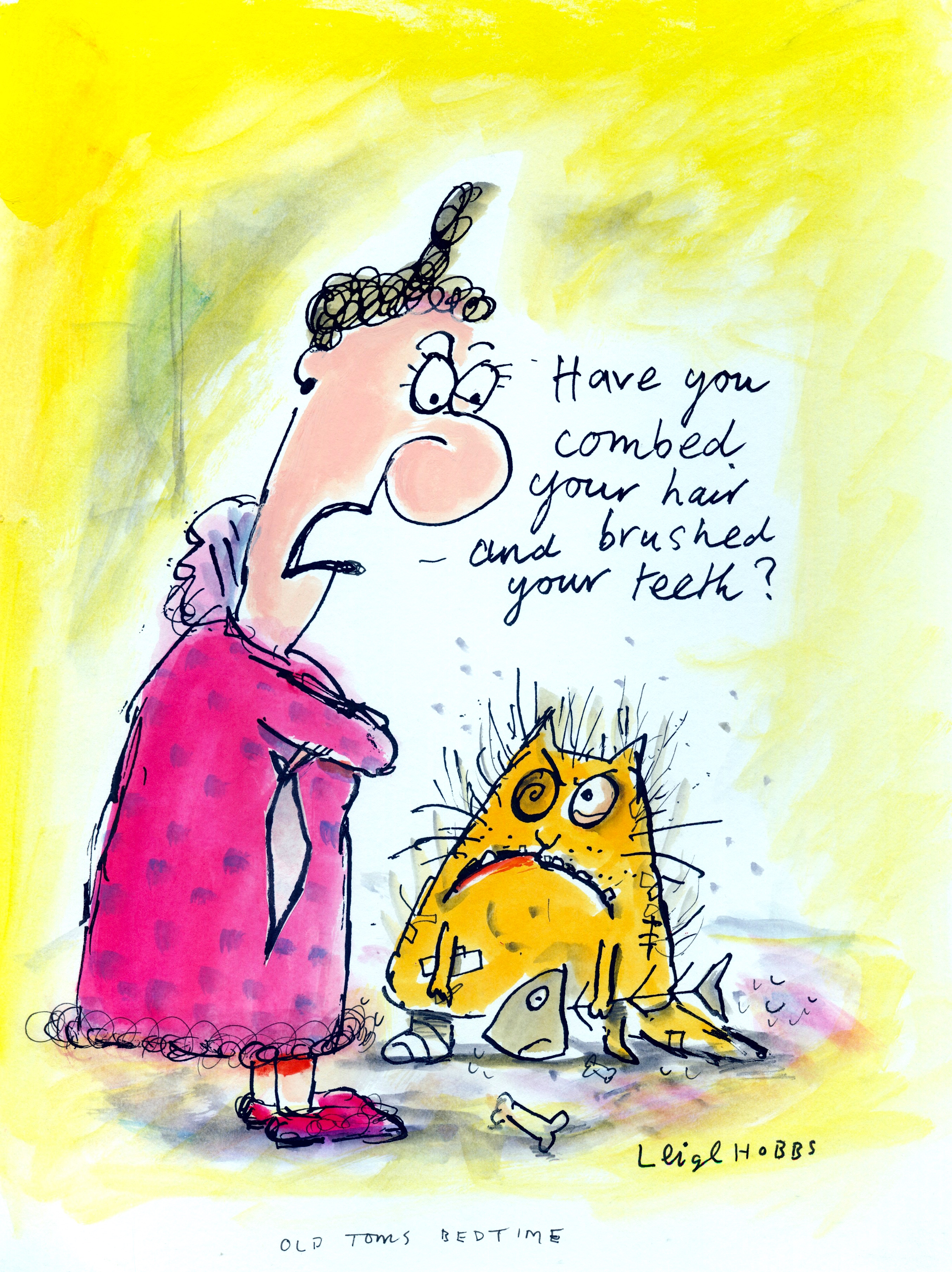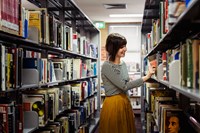Issue 106
Term 3 2018
Leigh Hobbs on the invaluable, irreplaceable school library
SCIS talks to Leigh Hobbs about the value of school libraries in engaging young people in creative activities, and how this can support student wellbeing.
Earlier this year, author and illustrator Leigh Hobbs finished his time as Australia’s Children’s Laureate for 2016–17. The role is to promote the importance and transformational power of reading and creativity for young people.
During Leigh’s two years as laureate, he passionately campaigned for school libraries and school librarians, as well as the need for young people to engage in creative participation. His campaign for school libraries was driven not by theory but by his own experience, from childhood to his current work as an author and illustrator.
I was fortunate to speak to Leigh about his time as laureate; why he thought it necessary to campaign for school libraries and the need for young people to engage in creative participation — and how these two are intimately entwined.

Photo by Robert Littlewood
‘As a boy in primary school,’ Leigh begins, ‘I got great value from the school library and the librarian who directed me toward certain books that, as it turned out, greatly influenced my life and my work. Then, as a teacher, I witnessed the value of school libraries not only as centres of learning and education, but places of pastoral care. And, thirdly, as a creator of children’s books and frequent visitor to schools, I see the value of them now, both here and overseas. Bureaucrats and politicians often talk about the need for literacy and pastoral care, but the school library, where there is a library, is ideally the very centre for these things.
‘I am absolutely convinced about the need for and the value of school libraries and school librarians. But librarians are all too often facing an uphill battle because of school funding. You can have a terrific principal who understands the value of the library and the librarian and fully supports it for years, then they leave and a replacement may withdraw all of its funding,’ says Leigh.
Reflecting on two years as laureate
Leigh’s laureateship was an eye-opener for him. ‘I think I learned as much as I taught,’ he reflects. ‘Over the course of the two years, I had 34 interstate and overseas trips. What was wonderful about that was meeting so many different people in different parts of Australia and the world. And, when it came to the kids and their wellbeing, and libraries, and books, and reading, and art, everything seemed to be interconnected. That was a wonderful thing to discover.’
Leigh was humbled by the ‘overwhelmingly positive’ response from the school library community during and following his laureateship. ‘In a very small way, I think that the librarians were glad to feel part of a passionate network, that they weren’t alone. Often libraries and librarians are isolated within the school. But they oughtn’t be — and, for their own survival, they mustn’t be.’
He thinks that school librarians ‘need to make themselves very much part of the school fabric and calibrate the library to the individual needs of not only the school but the students and the teachers, so that they are highly valued and deemed indispensable. Otherwise, other areas of the school will get in first and do their lobbying with the principal, who decides where the money goes.’
It was evident how deeply Leigh cares about school libraries as he shared anecdotes about their closure — one story was about a school library being packed up, with books put into a shipping container and stored by the side of the school oval. Despite this, he finds hope in the small changes he sees.
‘There was one occasion where two girls who had recently been enrolled in a school went home and mentioned to their mother that there was no library. The mother campaigned over a period of time, got on the school committee, and the school now has a library again. They don’t have a full-time librarian, but the library is up and running and they have someone who comes in a few days a week,’ Leigh says. ‘This is in a well-to-do inner-city Melbourne suburb,’ he adds. ‘So there are wins still amongst the losses.’
Engaging the imagination through stories
Leigh stresses the need to engage and nourish children’s imaginations; indeed, campaigning for creative participation was a large focus during his time as laureate. Children’s imaginations can often grow from seeds planted in the library, but it’s important to recognise that every child is different and their needs should be catered for accordingly. We can’t always prescribe books for people based purely on expected tastes or assigned reading levels.
I’ve visited a few schools where they have one hour a week where kids come into the library, and they can sit, read, draw, write poetry — it’s their time. It serves a pastoral function, which is really important for kids and their sense of self-worth.
Leigh suspects that as a child his imagination was nourished via the reference section as much as children’s novels and picture books. ‘I think that as a child and as an adult, I was hardly the cliché artist. I never wanted to stand out, be noticed, or be a revolutionary. On the outside I appeared conservative in a sense, but my inner life and imagination were ablaze and alight, full of mad characters and ideas.
‘Most of the books that I read and loved as a little boy were about English history, the French Revolution, London in the 18th century, castles, pirates, or the plague. There wasn’t much time left for me to read classic kids’ books like Wind in the Willows, although my father did read books like Treasure Island and Kidnapped to me, which I absolutely adored. I suppose in a sense I was a bit odd; my inner world was fed by these reference books.’
While it may seem like an odd relationship to some — reference books and creativity — we can see that this very juxtaposition has followed Leigh into his work as an author and illustrator. ‘I never set out to be a writer. I wanted to be an artist. The reason that I love doing both is that I can in fact create two distinct ‘voices’ within a picture book. The droll text says one thing — it is the adult voice — whereas the pictures are from a child’s point of view. So, the writing is life on the outside, all nice and conservative. But, within this, these sorts of berserk characters operate, and it’s playing with the two sides that enthuses me.’
The Mr Chicken series comes to mind when we consider the relationship between the adult words and the drawings intended for children. ‘Out of all my characters, Mr Chicken is the one that my editor and I find most mysterious as far as the children’s response. In a way, he’s got the least personality, but the kids seem to adore him. I suspect kids find Mr Chicken hilarious because he’s an affront to the adult grown-up world,’ Leigh says.
‘In spite of my books not appearing to be “issues-based”,’ Leigh says, ‘if you scratch the surface, you’ll find that these books were written from the heart, and they are in fact about things that I was affected by as a little kid. Old Tom is about the relationship between a mother and son. Fiona the Pig is about being yourself. Horrible Harriet is about not fitting in, and what it’s like to be a freak. Mr Chicken Goes to Paris is about friendship.
‘The reason they resonate with kids, I think, is that they aren’t just superficial cartoon characters. There are elements of truth and real life in the stories and characters that the kids consciously or unconsciously relate to,’ he says.
Escaping through the arts

During our conversation, I noticed parallels between Leigh’s understanding of libraries and the arts: they both provide opportunities for young people to let their guard down, and are ideally a refuge from expectations. Leigh often visits libraries and, together, he and the children draw his beloved character, Old Tom; it is here that these parallels surface.
‘Drawing Old Tom is merely a ploy to get them to relax. What I say to them is that all of their drawings are going to look like Old Tom, regardless of their individual abilities. Even if one of them draws a scribble, I can say, “This is Old Tom — this is how he is feeling”. If there is room, I ask all of the kids to stand in a circle and hold their drawings up, and I say, “Look, everyone’s drawing is Old Tom, and not one looks alike, because everyone is different”.
And that lets kids relax; they sense that they’re not being ranked. And then we move on to them creating their own characters, and their own drawings.’
In this sense, children can grow in their confidence and in their ability to take on new tasks. And Leigh’s understanding of this extends to libraries: ‘Kids are assessed right through their education. Even if a child isn’t “good” at something on some scale of assessment, I don’t think that should to deter them if they enjoy doing it. However, if they don’t get good marks, no matter how hard they try, they might just give up. There needs to be some context in which a child can read or write or draw for the love of it,’ Leigh explains.
‘And this is where the library is terrific,’ he continues. ‘I’ve visited a few schools where they have one hour a week where kids come into the library, and they can sit, read, draw, write poetry — it’s their time. And the teachers say that it’s fantastic. The teachers can be in there, and the librarian quietly wanders around, directing where needed. It serves a pastoral function, which is really important for kids and their sense of self-worth.’
Libraries support wellbeing
Leigh mentioned that during his laureateship, more than ever he was convinced that a sense of wellbeing in children could be reinforced by libraries, books, reading, and art. As our conversation meandered around these ideas, it became clear how entwined they are. Libraries are certainly capable of fostering a culture where books, reading and the arts can be both embraced and explored, opening doors for children to nourish and take delight in their own imaginations.
Image credits
Photo of Leigh Hobbs in studio by Robert Littlewood
Old Tom's Bedtime supplied by Leigh Hobbs
The interview extracts have been lightly edited and reordered where necessary to improve readability or clarity.
